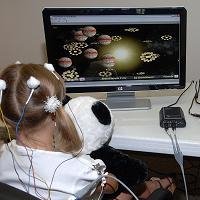Neurofeedback (also known as Brainwave Biofeedback or EEG Biofeedback) is a brain-based therapy for enhancing brain functioning and promoting self-regulation. It is a form of biofeedback that provides feedback from the electrical activity of the brain, thereby providing relaxation for the brain, which then leads to more efficient functioning.
The first published studies started appearing in the 1970’s. Advances in neuroscience and technology have resulted in increased research and clinical work each year.
It is a form of biofeedback that provides feedback from the electrical activity of the brain, thereby providing relaxation for the brain, which then leads to more efficient functioning.
 Our brains are continually discharging electrical activity at different speeds and power at different brain locations. Slower brainwaves are made when sleeping or daydreaming. When we are concentrating our brainwaves are faster. Individuals with ADD/ADHD often make more slow brainwaves in comparison to non-ADD individuals.
Our brains are continually discharging electrical activity at different speeds and power at different brain locations. Slower brainwaves are made when sleeping or daydreaming. When we are concentrating our brainwaves are faster. Individuals with ADD/ADHD often make more slow brainwaves in comparison to non-ADD individuals.
Overanxious individuals may have brainwaves that are excessively fast. Individuals with acquired brain injury, autistic spectrum disorder, and brain-based depression often have predictable EEG patterns. Neurofeedback helps individuals modify their brainwave patterns.
After neurofeedback training, individuals show clear and lasting gains in their symptoms. For example, ADHD individuals typically focus better, are less distractible and less impulsive. Many also show gains in other areas (e.g. sleep, emotional regulation and social functioning. They are often able to maintain these gains without medication or with less medication(s).
The problem is EEG dysregulation: brainwaves that are too slow or too fast. We train the brain to make more of some brainwaves while decreasing other types of brainwaves.
Researchers attribute these gains to the brain functioning in a more efficient and stable manner, with some researchers attributing that to improvements in cerebral blood flow.
Neurofeedback is commonly used to address ADHD, depression, anxiety disorders, autistic spectrum, learning disabilities, and migraines. It is often combined with other therapeutic and/or educational modalities, including psychotherapy and instruction in cognitive learning strategies.